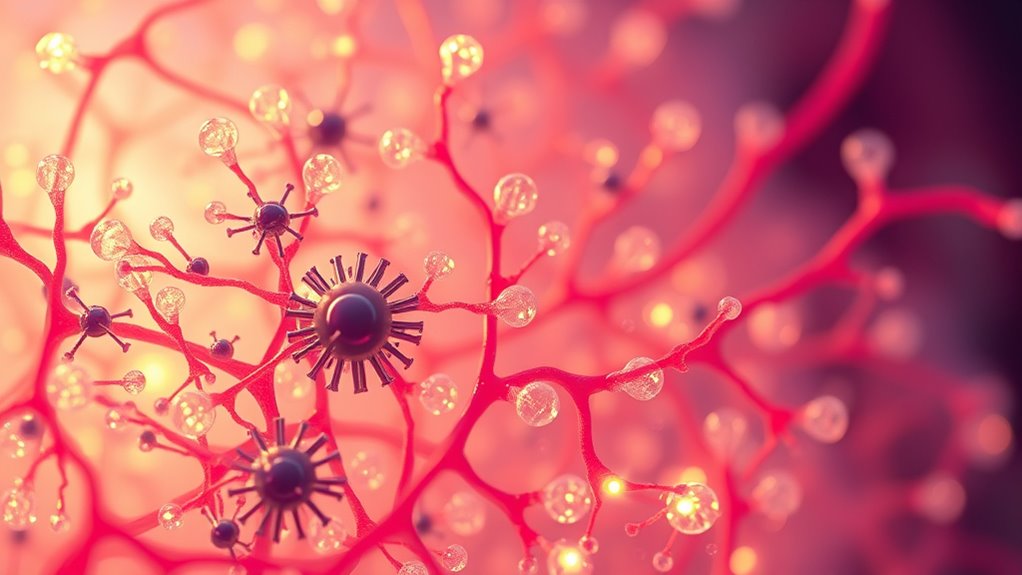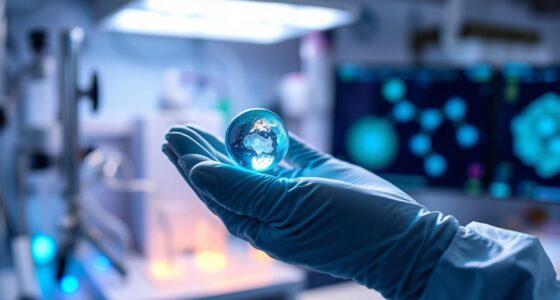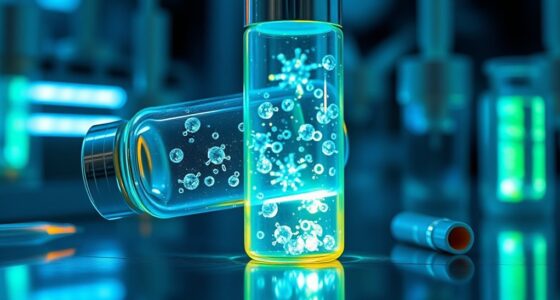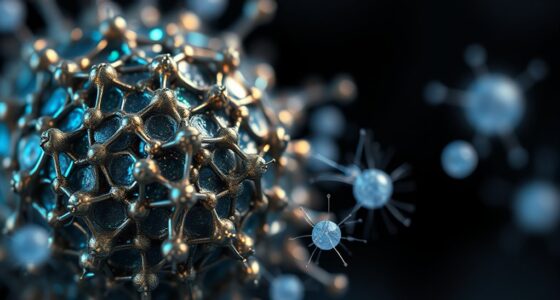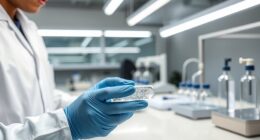Nanomachines are tiny devices designed to target cells, deliver drugs, and promote tissue repair with high precision. They operate at the cellular level, recognizing specific markers and responding to environmental cues. These innovations can improve healing, reduce side effects, and enable customized treatments. As they advance, they hold promise for automating tissue engineering and regeneration processes. Keep exploring to discover how these cutting-edge tools are transforming medicine and shaping future therapies.
Key Takeaways
- Nanomachines enable targeted drug delivery and controlled release, enhancing tissue regeneration precision and reducing side effects.
- They facilitate tissue engineering through biofabrication, allowing automated, high-accuracy assembly of complex, patient-specific tissues.
- Smart nanomachines respond to environmental stimuli, releasing growth factors or drugs to promote faster and localized healing.
- Advanced materials and bioengineering techniques support nanomachine integration for safe, biocompatible regenerative applications.
- Ethical, regulatory, and environmental considerations are critical in developing nanomachines for safe, sustainable regenerative medicine.
The Fundamentals of Nanomachines in Medicine
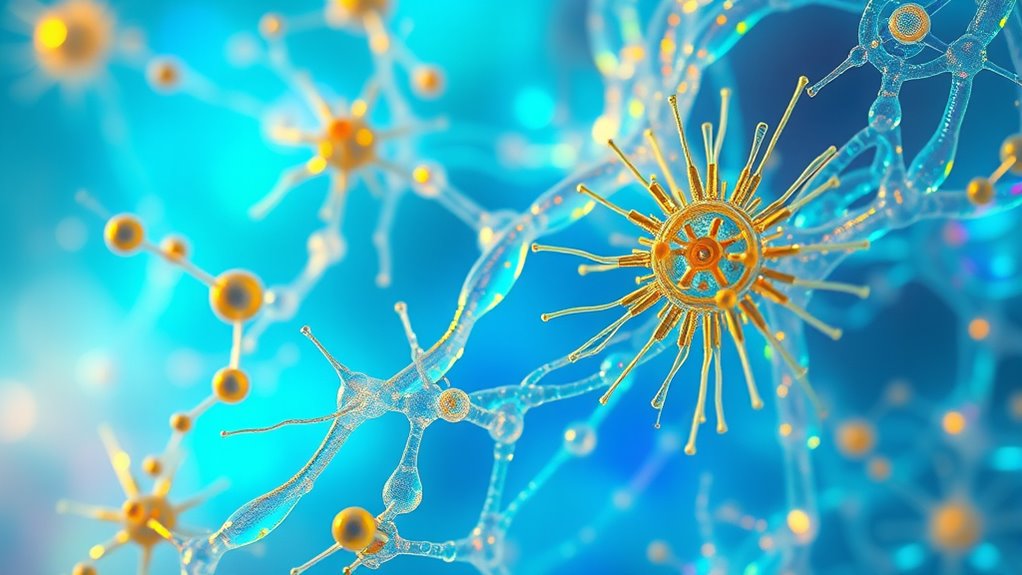
Nanomachines are tiny, engineered devices designed to perform specific tasks at the cellular and molecular levels, making them invaluable tools in medicine. They operate at a scale where they can interact directly with cells, molecules, and even individual proteins. These devices are constructed using advanced nanotechnology, allowing precise control over their size, shape, and function. You can think of nanomachines as microscopic surgical tools or delivery systems that can target specific sites within the body. They can manipulate biological processes, transport drugs, or repair damaged tissues with high accuracy. Their ability to function at such a small scale opens new horizons in diagnostics, targeted therapies, and regenerative medicine, transforming how you approach complex medical challenges. Additionally, high precision in their design enables nanomachines to perform complex tasks with minimal side effects, enhancing their effectiveness in regenerative medicine.
Designing Nanomachines for Cellular Interaction
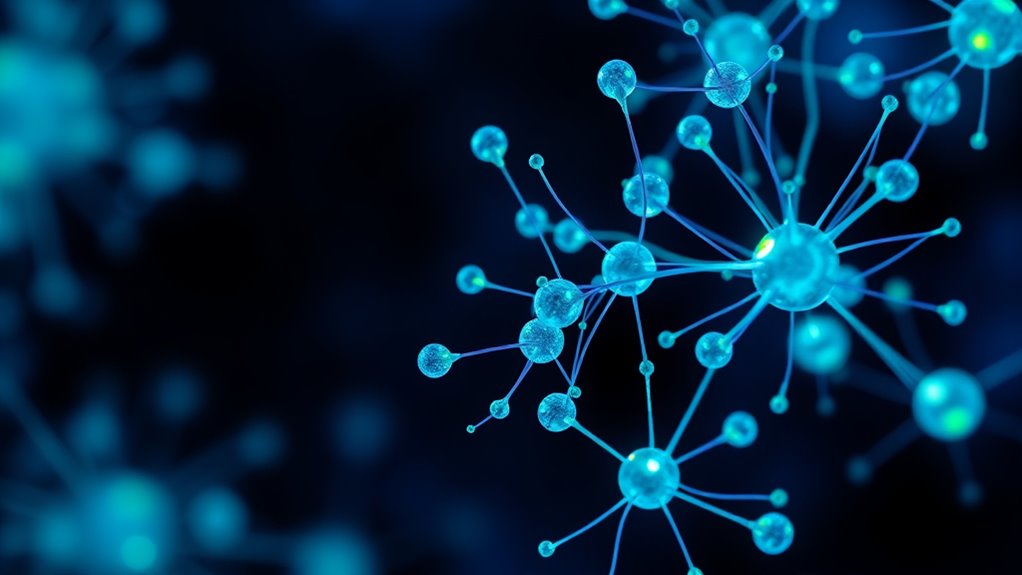
Building on their ability to perform precise tasks at the cellular level, designing nanomachines for cellular interaction requires careful consideration of how these devices will identify and engage with target cells. To achieve this, you must focus on:
- Surface recognition molecules that bind selectively to cell-specific markers
- Signal transduction pathways to ensure proper communication with the cell
- Responsive structures that adapt to the cell’s environment
- Minimal immune response to prevent rejection or unintended interactions
- Incorporating vetted materials to ensure safety and effectiveness in biological systems.
Delivery of Therapeutic Agents Using Nanomachines
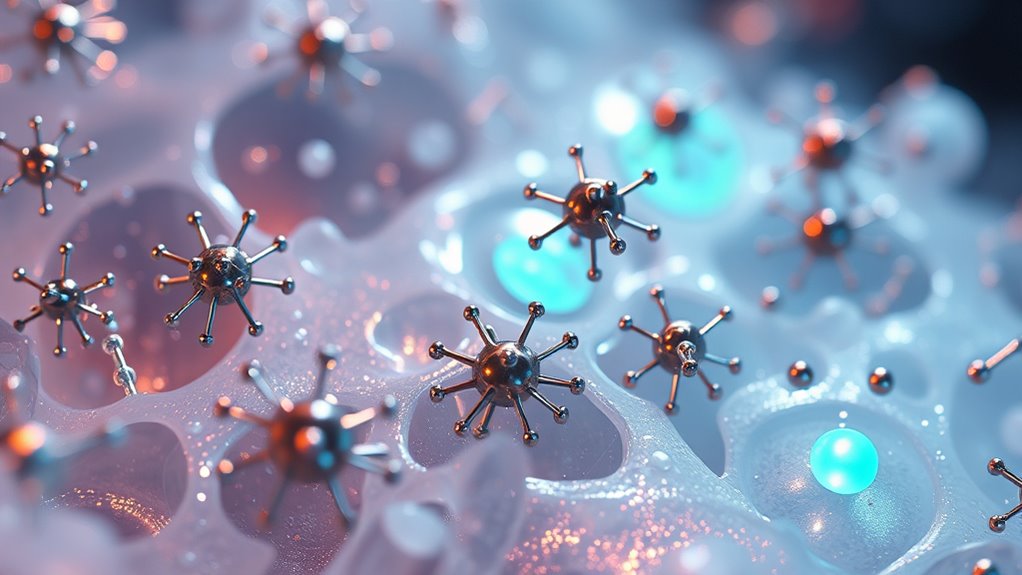
You can harness nanomachines to deliver therapeutic agents precisely where needed, enhancing effectiveness. By implementing targeted delivery mechanisms and controlled release strategies, you guarantee drugs reach the right cells at the right time. This approach helps minimize side effects and maximizes treatment benefits. Incorporating precision medicine techniques can further optimize delivery outcomes.
Targeted Delivery Mechanisms
Targeted delivery mechanisms harness nanomachines to precisely transport therapeutic agents to specific tissues or cells, minimizing side effects and increasing treatment efficacy. These systems rely on advanced targeting strategies, such as surface ligands that recognize cell markers, magnetic guidance, pH-sensitive triggers, and enzyme-responsive features. By integrating these methods, you can guarantee nanomachines reach the intended site with high accuracy. This precision reduces off-target effects and enhances therapeutic outcomes. For example, surface ligands can bind to overexpressed receptors, while magnetic nanoparticles respond to external fields. pH-sensitive features activate in acidic tumor environments, and enzyme-responsive mechanisms release drugs upon encountering specific enzymes. Such targeted delivery improves treatment efficiency and minimizes damage to healthy tissues, paving the way for safer, more effective regenerative therapies. Incorporating vetted Halloween product reviews can help in selecting suitable costumes for medical professionals or patients involved in therapeutic events.
Controlled Release Strategies
Controlled release strategies enable nanomachines to deliver therapeutic agents precisely when and where they’re needed, ensuring ideal treatment outcomes. By programming nanomachines to release drugs gradually or in response to specific stimuli, you can maintain beneficial drug concentrations over time, reducing the frequency of administration. These strategies improve treatment efficiency and minimize systemic exposure, lowering side effects. Techniques like pH-sensitive or enzyme-triggered release allow nanomachines to respond to local biological signals, ensuring targeted delivery. You can also incorporate biodegradable materials that break down at controlled rates, releasing agents steadily. This level of control enhances regenerative processes, supports tissue repair, and allows for personalized therapy plans, making nanomachines a powerful tool in advancing regenerative medicine and tissue engineering. Emotional Support can also be integrated into treatment plans to improve patient compliance and overall outcomes.
Minimizing Side Effects
Nanomachines help minimize side effects by delivering therapeutic agents directly to the affected tissues, reducing exposure to healthy cells. This targeted approach enhances treatment efficacy while limiting unintended damage. To achieve this, nanomachines:
- Recognize specific biomarkers, ensuring precise targeting.
- Release drugs only upon reaching the diseased site.
- Bypass healthy tissue, avoiding unnecessary toxicity.
- Adjust dosage in real-time based on tissue response.
- Incorporate elements of targeted therapy, further improving treatment specificity and safety.
Repair and Regeneration of Damaged Tissues
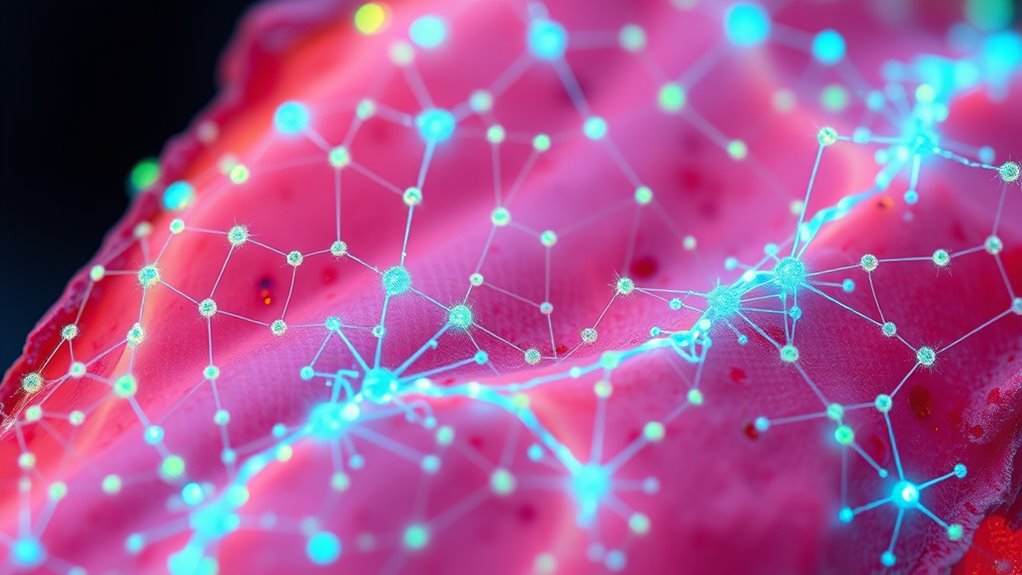
When tissues sustain damage, restoring their function requires more than just healing; it demands precise intervention at the cellular and molecular levels. Nanomachines can target specific cells or damaged areas, delivering therapeutic agents directly where needed. They can facilitate tissue repair by stimulating cell growth, promoting extracellular matrix production, or removing harmful debris. These tiny devices operate with high accuracy, reducing the risk of collateral damage and improving recovery outcomes. By mimicking natural biological processes, nanomachines enable controlled, localized regeneration, which is especially valuable for complex tissues like nerves, cartilage, or muscles. Their ability to integrate seamlessly into tissue environments accelerates healing and restores functionality more effectively than conventional methods, making them a promising tool in regenerative medicine.
Advantages Over Traditional Regenerative Techniques

What makes nanomachines stand out from traditional regenerative techniques is their ability to deliver targeted treatments at the cellular level. This precision enhances effectiveness and reduces side effects. First, nanomachines can navigate directly to damaged cells, ensuring localized therapy. Second, they can release therapeutic agents in controlled doses, optimizing healing. Third, their size allows them to cross biological barriers that block larger delivery systems. Fourth, nanomachines can adapt to dynamic tissue environments, providing real-time responses. These capabilities outperform conventional methods like grafts or systemic drugs, which often lack specificity and risk unintended effects. Overall, nanomachines offer a more precise, efficient, and adaptable approach to tissue regeneration, opening new possibilities for personalized medicine and improved patient outcomes.
Challenges in Developing Medical Nanomachines

Despite their promising advantages, developing effective medical nanomachines presents significant hurdles. You face complex fabrication challenges, as creating nanoscale devices with precise control and functionality remains difficult. Biocompatibility is another critical concern; your nanomachines must avoid triggering immune responses or toxicity. Ensuring targeted delivery without unintended interactions demands sophisticated design and testing. Powering these devices is also problematic—you need reliable, miniature energy sources that function within the body. Additionally, controlling and monitoring nanomachines in vivo requires advanced sensing and communication systems. Regulatory approval adds further complexity, as ensuring safety and efficacy involves rigorous testing. Overcoming these obstacles demands interdisciplinary collaboration, innovative engineering, and thorough understanding of biological environments. Without addressing these challenges, translating nanomachines from concept to clinical reality remains a formidable task. Furthermore, research into eco-friendly materials can contribute to safer and more sustainable solutions for nanomachine development.
Future Perspectives and Emerging Technologies

Looking ahead, nano-robotic biofabrication promises precise construction of tissues and organs at the cellular level. Integrating smart biomaterials will enable these nanomachines to respond dynamically to their environment, enhancing regeneration. Glycolic acid is also being explored for its potential to improve tissue regeneration by promoting cellular turnover. Together, these emerging technologies could revolutionize regenerative medicine and tissue engineering.
A) Nano-Robotic Biofabrication
Nano-robotic biofabrication is poised to revolutionize regenerative medicine by enabling precise construction of tissues and organs at the cellular level. With this technology, you can expect a level of accuracy that surpasses current methods, reducing errors and improving outcomes. Imagine:
- Automated assembly of complex tissue architectures
- Real-time correction of structural imperfections
- Customization of tissues tailored to individual patient needs
- Integration of multiple cell types seamlessly
These advancements will allow you to create functional tissues with unmatched precision, accelerating transplantation and healing processes. As nano-robots become more sophisticated, they’ll facilitate highly controlled environments for cell growth and differentiation, pushing regenerative medicine into a new era of personalized, efficient solutions. This technology promises to transform how we approach tissue engineering in the future. Forsale 100
B) Smart Biomaterials Integration
Emerging technologies are driving the development of smart biomaterials that can dynamically interact with their environment to enhance tissue regeneration. These materials respond to stimuli like pH, temperature, or mechanical forces, allowing real-time adaptation. You’ll see innovations where biomaterials release growth factors or drugs precisely when needed, promoting faster healing. Incorporating nanomachines enables these materials to sense changes and adjust their properties accordingly. This synergy improves cell adhesion, proliferation, and differentiation, making regenerative therapies more effective. Future prospects include integrating sensors and actuators within biomaterials for personalized treatment. Additionally, understanding water quality and flow rates can be crucial when designing implantable devices or scaffolds to ensure compatibility and safety. By harnessing these emerging technologies, you’re paving the way for smarter, more responsive tissue engineering solutions that could revolutionize regenerative medicine and improve patient outcomes.
Ethical Considerations and Safety Aspects
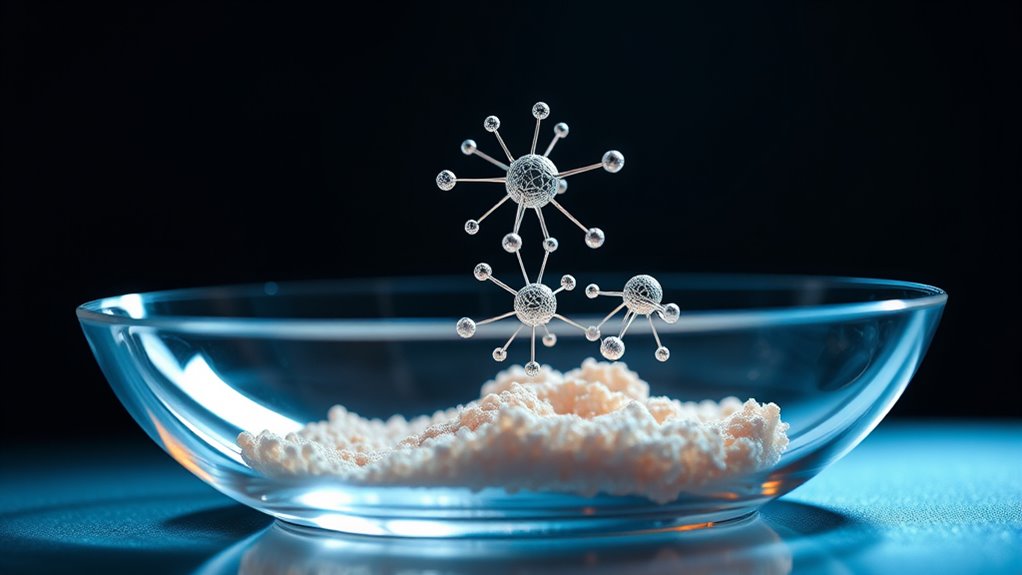
As nanomachines become more integrated into regenerative medicine and tissue engineering, addressing ethical considerations and safety concerns becomes essential. You must consider potential risks, such as unintended biological interactions, long-term effects, and environmental impact. Here are four key points to keep in mind:
- Ensuring patient safety through rigorous testing and regulation.
- Preventing misuse or malicious applications of nanomachines.
- Addressing informed consent and public transparency.
- Evaluating ecological and societal implications of widespread deployment.
Balancing innovation with responsibility is critical. You need to prioritize safety protocols, ethical guidelines, and transparent communication to foster trust and minimize risks associated with these advanced technologies.
Frequently Asked Questions
How Do Nanomachines Differentiate Between Healthy and Diseased Tissues?
You can think of nanomachines differentiating between healthy and diseased tissues by recognizing specific markers or signals unique to diseased cells. They detect differences in surface proteins, pH levels, or biochemical environments. Once identified, they activate to target only the diseased tissue, sparing healthy cells. This precise recognition allows nanomachines to deliver treatments directly where needed, improving effectiveness while minimizing side effects.
What Are the Potential Long-Term Biological Impacts of Nanomachine Use?
You might face long-term biological impacts like immune responses or unforeseen tissue interactions. Nanomachines could accumulate in organs, causing toxicity or disrupting normal functions over time. There’s also a risk they might trigger genetic changes or interfere with cell processes. While ongoing research aims to minimize these risks, you should stay informed about safety developments, as the full long-term effects of nanomachine use remain uncertain.
How Scalable Are Nanomachine Production Methods for Clinical Applications?
You might find that nanomachine production methods are steadily becoming more scalable for clinical applications, but it’s still a tall order to meet large-scale demands. Advances in manufacturing techniques, like automation and precision synthesis, help bridge the gap. However, challenges remain in ensuring consistent quality, cost-effectiveness, and regulatory approval. While the industry is making strides, it’s a journey, not a sprint, towards widespread clinical use.
Can Nanomachines Be Programmed for Autonomous Operation Within the Body?
Yes, nanomachines can be programmed for autonomous operation within the body. Researchers design them with sensors and control systems that allow them to respond to specific biological signals or conditions. You can imagine them as tiny robots that navigate, target, and perform tasks like drug delivery or tissue repair independently. Advances in bioengineering and control algorithms continue to enhance their precision, making autonomous nanomachines increasingly feasible for medical applications.
What Regulatory Pathways Are Necessary for Approving Nanomachines in Medicine?
Think of regulatory pathways as the GPS guiding your nanomachines through the complex landscape of medicine approval. You’ll need to navigate agencies like the FDA, submitting detailed safety and efficacy data. Clinical trials are your checkpoints, proving these tiny machines are safe and effective. You’ll also face review processes that guarantee compliance with standards. This journey ensures your nanomachines earn the trust needed for safe, effective medical use.
Conclusion
You now see how nanomachines revolutionize medicine by enabling precise repair, targeted delivery, and tissue regeneration. You understand their design for cellular interaction, their advantages over traditional methods, and the challenges to overcome. You recognize the potential for future innovations and the importance of ethical considerations. Embrace the possibilities, navigate the challenges, and contribute to the evolving world of nanomedicine—where technology, medicine, and ethics come together to shape healthier futures.
